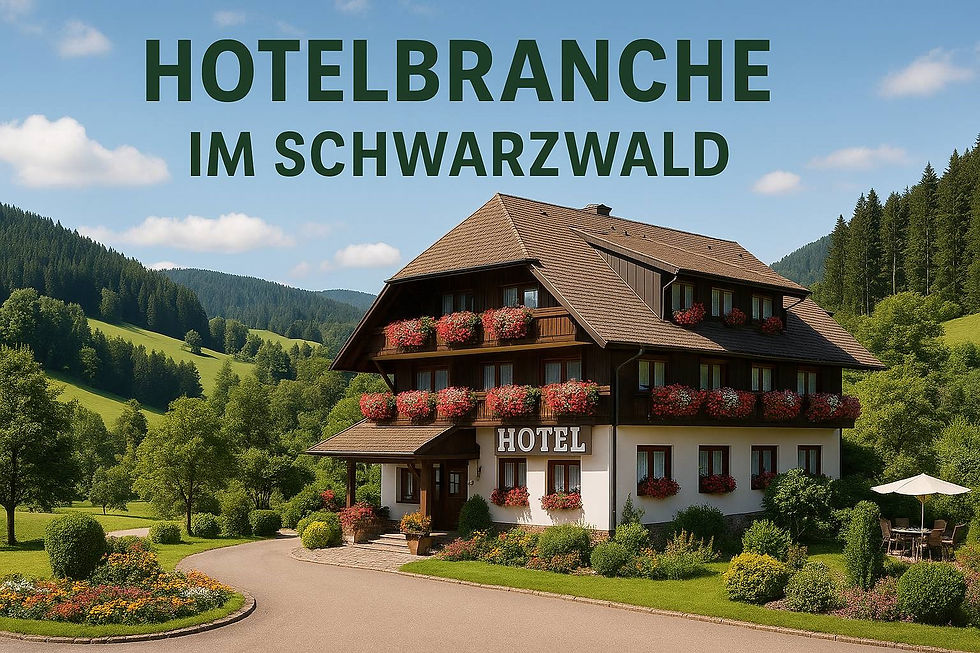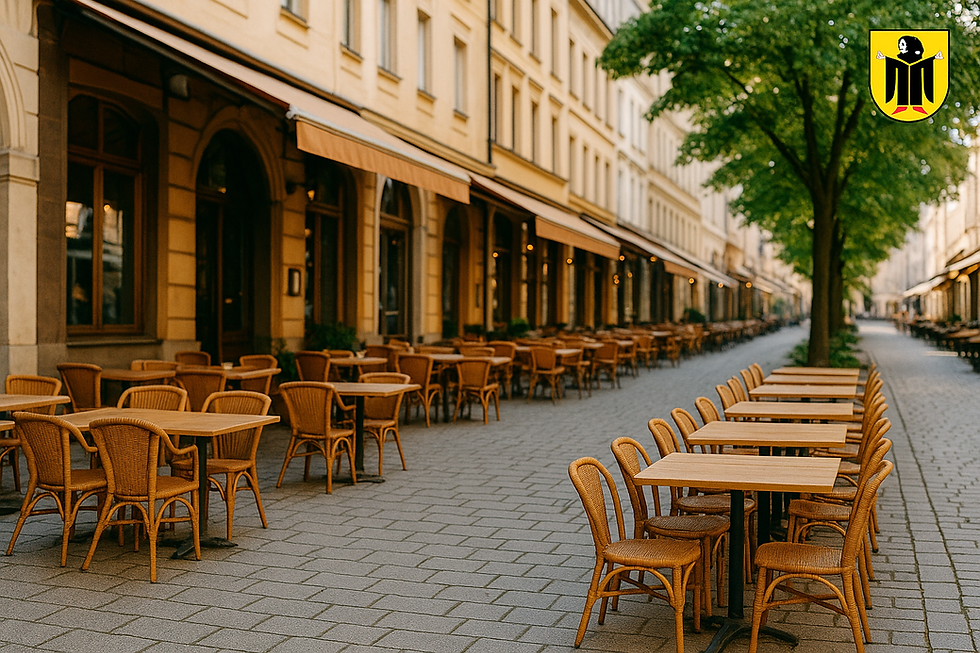Development of overnight stays in the Black Forest
- H.Genzlinger

- Aug 17
- 5 min read
Development of overnight stays in the Black Forest 2019–2024: Market analysis with current statistics, trends, and hotel shares.

Executive Summary
The Black Forest has established itself as Germany's most successful tourism region, setting a historic record of 23.32 million overnight stays in 2024. Following the pandemic-related declines in 2020/2021, the region not only exceeded the pre-crisis level of 2019 by over 10%, but also set new standards for sustainable tourism in Germany.
The hotel industry is benefiting disproportionately from this boom, accounting for the largest share of all overnight stays at 63.2%. This development offers excellent investment and business opportunities for the hospitality real estate sector.
23.32 million
Overnight stays 2024
+1.1%
Growth vs. 2023
63.2%
Hotel share
+10.0%
vs. Pre-Corona (2019)
Development of overnight stays 2019-2024 (in millions)
Detailed market development -
Historical time series and turning points
The development of overnight stays in the Black Forest reveals a remarkable success story with significant turning points. Starting from a solid foundation of 21.2 million overnight stays in 2019, the region experienced the most dramatic decline in its tourism history.
Key observation: The hotel industry proved to be exceptionally resilient. Despite dramatic fluctuations, the hotel share of total overnight stays remained constant at 63.2%, underscoring the structural strength and guest preference for professional hotels.
Regional market analysis
Southern Black Forest - The market leader
With 8.9 million overnight stays (38.2%), the Southern Black Forest dominates the tourism scene. This region benefits from its proximity to Switzerland, the Black Forest's highest peaks, and an excellent tourism infrastructure. The areas around Titisee-Neustadt, Feldberg, and the border triangle in particular experience consistently high demand.
Northern Black Forest - Growth Region
The Northern Black Forest achieved 6.7 million overnight stays (28.7%) , showing the strongest percentage growth of all regions. Its proximity to the Stuttgart and Karlsruhe metropolitan areas, combined with attractive wellness offerings in Baden-Baden and Freudenstadt, makes this region particularly attractive for short break travelers and business travelers.
High Black Forest - Seasonal top region
With 4.8 million overnight stays (20.6%), the Black Forest region exhibits the most pronounced seasonal structure. Winter and summer seasons here reach similarly high peaks, allowing hoteliers to achieve optimal annual occupancy.
Seasonality and capacity optimization
The seasonal analysis shows a remarkably even distribution of overnight stays throughout the year, providing hoteliers with a predictable basis for planning. While the traditionally strong summer months of July and August continue to dominate, the off-peak seasons are steadily gaining in importance.
Capacity optimization: The improved distribution across all months offers hotels the opportunity to optimize their annual capacity utilization and become less dependent on seasonal fluctuations.
High season (June - August)
The summer months continue to record the highest demand, with 8.0 million overnight stays (34.3% of the annual volume). Family vacationers, hikers, and cyclists dominate the guest spectrum.
Off-season potential
Particularly noteworthy is the increase in the transition months of March/April and September/October. These periods offer hotels optimal conditions for premium prices in a relaxed atmosphere.
Accommodation structure and market opportunities
An analysis of the accommodation structure clearly demonstrates the dominance of the professional hotel industry. This market position offers excellent prospects for both established hoteliers and investors in hospitality properties.
Hotel industry - The market leader (63.2%)
Hotels and bed-and-breakfast hotels clearly dominate the market, with 14.74 million overnight stays . This guest preference for professional service, reliable quality, and comprehensive services underscores the attractiveness of hotel investments in the Black Forest.
Parahotellerie - Growing supplementary market (25.6%)
Vacation apartments and houses account for 5.97 million overnight stays and primarily serve longer stays and family groups. This segment offers potential for complementing diversified hotel portfolios.
Investment opportunity: The hotel industry's stable 63.2% market dominance combined with record-high total figures creates an ideal environment for hotel investments and expansions.
Success factors and market dynamics
Positive market dynamics
Nature-based tourism boom: Increased demand for authentic, nature-based experiences
Wellness and health: Black Forest as Germany's leading wellness destination
Active tourism: Hiking, e-bike tours and outdoor activities as growth drivers
Culinary excellence: Regional cuisine and Black Forest specialties as a USP
Digitalization: State-of-the-art booking and service technologies
Sustainability: Pioneering role in environmentally conscious tourism
Structural advantages
Geographical location: Central position in Europe with excellent accessibility
Infrastructure: Excellent transport links and tourist infrastructure
Diversity: Different landscapes for diverse target groups
Quality standards: Traditionally high standards in the hotel industry
Events and culture: Year-round offering of events and cultural highlights
Challenges and risk management
Critical success factors: Despite the excellent market position, structural challenges exist that require proactive management.
Personnel challenges
The shortage of skilled workers in the hotel industry represents the greatest operational challenge. Solutions include improved working conditions, digitalization to increase efficiency, and innovative recruitment strategies.
Cost dynamics
Rising energy, personnel, and raw material costs are putting pressure on margins. Successful hotels are addressing this challenge through efficiency improvements, sustainability investments, and strategic pricing.
Climate change and sustainability
Changing weather conditions require adaptation strategies for both the winter and summer seasons. At the same time, guests' sustainability expectations are continually increasing.
Market forecast and future scenarios
Short-term forecast (2025)
For 2025, we expect stabilization at a high level with moderate growth of 1-3%. Overnight stays are expected to be between 23.5 and 24.0 million , with an increased focus on improving quality and sustainability.
Medium-term development (2025-2027)
The medium-term development will be characterized by:
Sustainable tourism: Certified eco-hotels as a growth segment
Digitalization: AI-supported services and fully automated processes
Wellness expansion: Medical wellness and health tourism as a premium segment
Year-round optimization: Better utilization in traditional off-seasons
Long-term vision: The Black Forest continues to position itself as a destination for sustainable premium tourism with a focus on wellness, nature, and authentic experiences.
Strategic recommendations for investors and hoteliers
For hotel investors
Location selection: Focus on established tourism areas with development potential
Concept development: Target group-specific offers (wellness, family, business)
Sustainability investment: Green technologies as a differentiating factor
Digitalization: Modern booking and management systems
For existing hoteliers
Quality offensive: Continuous improvement of service standards
Employee development: investments in personnel and training
Revenue Management: Optimized pricing and capacity management
Cooperations: Partnerships with local suppliers and service providers
For hospitality real estate specialists
Market observation: Continuous monitoring of developments
Consulting expertise: Specialization in Black Forest-specific requirements
Network building: Strong connections to local stakeholders
Trend anticipation: Early identification of new business models
Conclusion and outlook
The Black Forest has established itself as Germany's most successful tourism region , offering investors and hoteliers exceptional market opportunities. With 23.32 million overnight stays in 2024, this not only set a historic record but also demonstrated the region's structural strength.
The dominance of the hotel industry, with a 63.2% market share, underscores guests' preference for professional accommodation and creates a solid foundation for investment. The simultaneous strengthening of all subregions and the improved annual distribution of overnight stays significantly reduce investment risks.
Investment recommendation: The Black Forest currently offers a unique combination of proven market success, structural stability, and further growth potential. The region represents a prime opportunity for specialized hospitality real estate investors.
The future outlook remains consistently positive . The trend toward nature-oriented, sustainable tourism is playing into the Black Forest's hands, while digital transformation is opening up new efficiency and service potential. Hotels that adapt early to changing guest needs and invest in quality and sustainability will benefit disproportionately from the ongoing boom.
© ABSOLUT GastronomieYour specialist for gastronomy and hotel properties in Southern GermanyData sources: Baden-Württemberg State Statistical Office, Black Forest Tourism GmbH, Destatis, Statista & Colliers
As of: July 2025 | All rights reserved




Comments